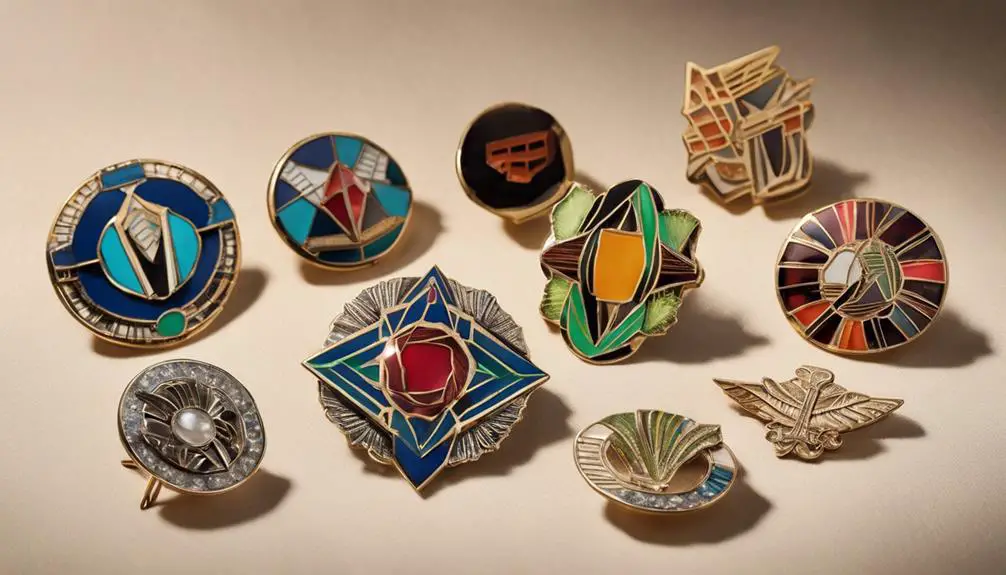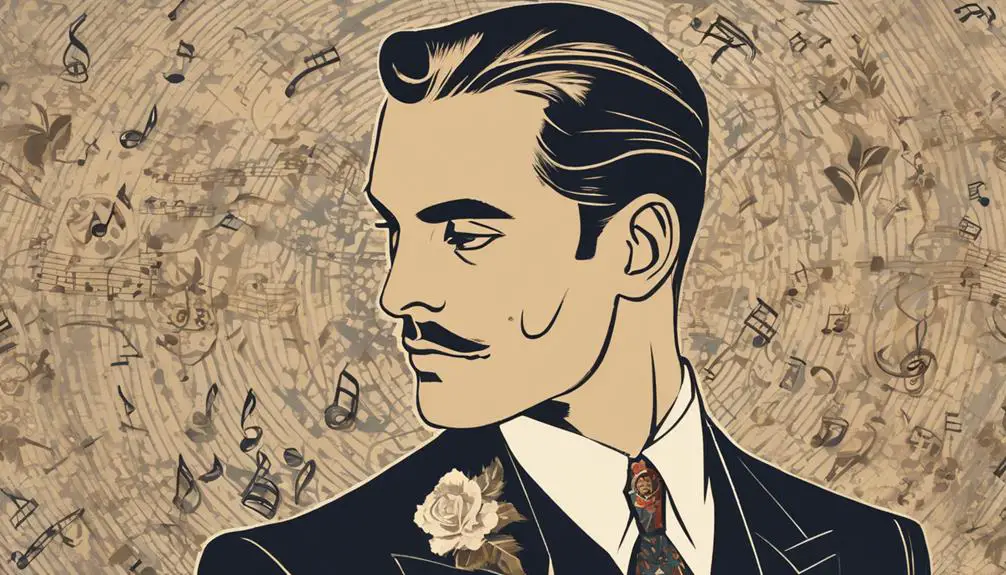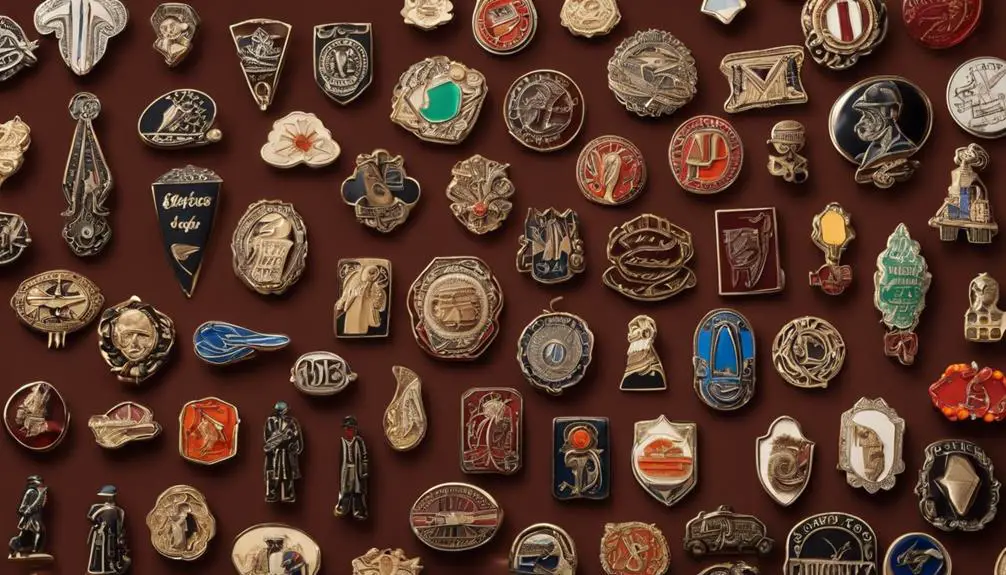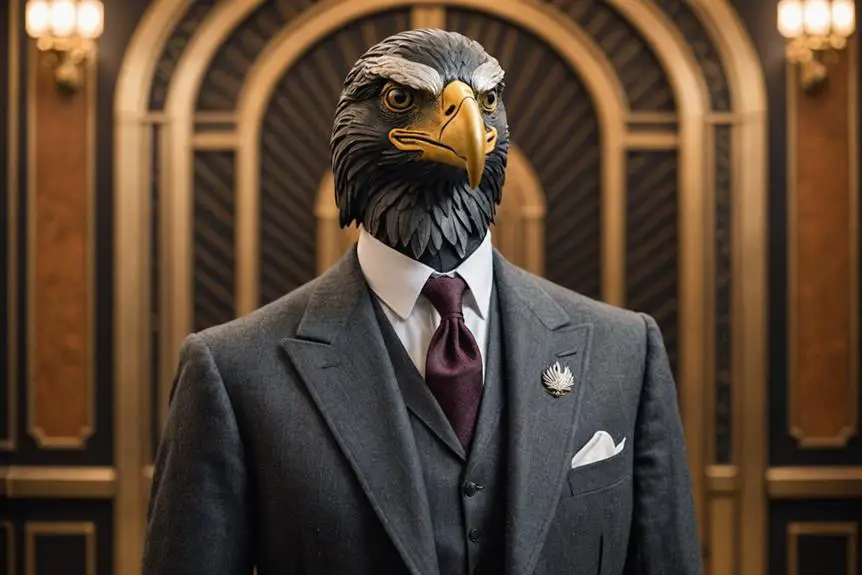In the 1930s, men's lapel pins weren't just cool accessories; they were all about making a statement! Influenced by the funky Art Deco movement, these pins boasted bold designs, geometric shapes, and flashy materials like Bakelite and chrome. Wearing one showed off your style, social status, and even your beliefs—talk about wearing your heart on your sleeve! You'd find floral motifs or quirky animal shapes that added flair to any outfit. Whether at a wedding or a classy event, these pins were your go-to. Interested in how to rock one? Stick around, and there's more fun to discover!
Evolution of Lapel Pins

Lapel pins frequently evolved throughout the 1930s, becoming a key accessory in men's fashion. Can you imagine stepping out in a dapper suit, only to have it accentuated by a vibrant lapel pin? That's exactly what happened! With the influence of the Art Deco movement, lapel pins transformed into eye-catching pieces featuring geometric patterns and bold colors. Rather than just being a simple accessory, they became a statement of style and personality.
During this time, lapel pins were more than just shiny objects; they often represented membership in clubs or organizations. Many designs incorporated intricate enamel work, making each pin a small work of art. And let's not forget about floral lapel pins! These stylish alternatives to traditional boutonnieres offered men a chance to showcase their flair while adding a touch of elegance to their outfits. Who knew flowers could be so manly?
As you explore the world of 1930s lapel pins, you'll discover that collectibility has skyrocketed over the years. Vintage pins are now sought after by enthusiasts who appreciate their historical significance and craftsmanship. So, if you're lucky enough to come across one, don't hesitate! Snatch it up and add a piece of history to your wardrobe. In the grand scheme of men's fashion, lapel pins played a pivotal role, proving that even the smallest details can make a big impact. Why not join the trend?
Art Deco Influence
While the 1930s embraced a variety of fashion trends, the influence of the Art Deco movement on men's lapel pins stands out as particularly striking. These lapel pins weren't just accessories; they were bold statements. The Art Deco style brought in geometric shapes and vibrant colors, transforming ordinary lapels into eye-catching fashion statements.
So, what made these lapel pins so special? Let's break it down:
- Materials: Many lapel pins featured innovative materials like Bakelite and chrome. These materials weren't just trendy; they showcased the era's fascination with modernity and technology.
- Designs: Art Deco lapel pins often included intricate motifs. You'd see floral designs and exotic animal figures, tapping into the era's love for nature and adventure. Imagine a lapel pin adorned with mother of pearl, glinting in the light!
- Social Status: Wearing a lapel pin became a symbol of style and sophistication. Gentlemen donned these pins at formal events, showcasing not only their fashion sense but also their social standing.
Today, collectors value these 1930s Art Deco lapel pins for their craftsmanship and historical significance. Prices can range from affordable finds to rare treasures worth hundreds! So, if you ever come across one, consider it a little piece of history that can elevate your style! What a cool conversation starter, right?
Popular Designs and Themes

When you think about men's lapel pins from the 1930s, what comes to mind? You've got iconic floral motifs that just pop, along with cool geometric shapes that scream Art Deco flair. Plus, many of these pins carried historical significance, representing organizations that were doing good in the world—how neat is that?
Iconic Floral Motifs
Floral motifs really took center stage in men's lapel pins during the 1930s, showcasing a blend of elegance and artistic flair. You could spot eye-catching designs featuring roses, daisies, and lilies, all crafted from materials like enamel, Bakelite, and chrome. These pins weren't just for decoration; they represented personal style and status.
So, what made these floral designs so special? Here are three key reasons:
- Floral Color Palettes: The vibrant colors used in these pins added a lively touch to any suit, making them a must-have accessory for formal events.
- Seasonal Motifs: Pins often reflected the seasons, with designs that captured the essence of spring or summer, adding a fresh vibe to your outfit.
- Lapel Pin Care: Taking care of your floral lapel pin not only preserves its beauty but also keeps its story alive. A little polish goes a long way!
Whether you're dressing up for a wedding or a fancy dinner, a floral lapel pin can elevate your look. So, why not embrace this vintage charm? After all, who doesn't love a little elegance with their outfit?
Historical Symbolism and Significance
Men's lapel pins from the 1930s carry a rich historical symbolism that reflects the era's artistic and cultural movements. You'd see designs inspired by the flashy Art Deco style, featuring bold geometric shapes and bright colors. These pins weren't just accessories; they represented societal values and personal identity. Think about it—floral motifs, animal representations, and unique insignias conveyed messages about who you were and what you stood for.
In the historical context of the 1930s, many lapel pins also had wartime symbolism. For instance, some commemorated the Civil Nursing Reserve, highlighting the importance of service during a time of global conflict. Wearing one of these pins was like wearing a badge of honor, showing off your support for significant causes.
Today, collectors treasure these vintage items not just for their craftsmanship but for the stories they tell. Isn't it fascinating how something so small can hold so much meaning? Next time you see a vintage lapel pin, remember that it's more than just a piece of jewelry; it's a little window into the past, revealing the hopes, dreams, and values of a bygone era.
Materials and Craftsmanship Trends
Crafted with an eye for detail and a flair for design, lapel pins in the 1930s showcased a variety of materials that reflected the innovative spirit of the era. You'd find chrome, glass, and Bakelite making bold statements on these fashionable accessories. It's amazing how craftsmanship techniques of the time allowed for intricate designs and polished finishes that really stood out!
Popular designs and themes included:
- Floral Motifs – Bringing nature to your lapel, these designs added a touch of elegance.
- Abstract Shapes – Geometric patterns captured the essence of the Art Deco movement.
- Animal Designs – For those who wanted to show off their wild side!
Material innovations like rhinestones and vintage celluloid infused a bit of glamour into men's fashion. Plus, many pins were crafted as enamel badges, which allowed for eye-catching details. These design aesthetics weren't just pretty; they represented the social movements and trends of the time. So, whether you're a collector or just appreciate style, these lapel pins tell a rich story. Isn't it fascinating how a small accessory can carry so much history?
Cultural Significance
When you think about lapel pins in the 1930s, it's not just about looking sharp; these little accessories packed a punch! They were a way for guys to show off their style and even signal their membership to clubs, like a secret handshake but with flair. So, how did these tiny pins reflect the fashion trends and identities of the day?
Fashion Trends Influence
Elegance defined the fashion landscape of the 1930s, with lapel pins emerging as powerful symbols of social identity. You might wonder why these little accessories mattered so much. Well, they weren't just pretty—they reflected your social status and fashion identity during a time when appearances counted for everything.
Here're three reasons lapel pins were a big deal back then:
- Club Affiliation: Wearing a specific lapel pin signified membership in exclusive clubs or organizations, showcasing your social circle.
- Art Deco Influence: The bold geometric patterns and vibrant colors inspired by the Art Deco movement made these pins not just accessories, but pieces of art that stood out on suits.
- Economic Shift: With the Great Depression, men leaned towards subtle elegance. Lapel pins became a way to display sophistication without being flashy, showing that you could still look sharp on a budget.
Symbolism and Identity
Lapel pins in the 1930s weren't just fashion statements; they were powerful symbols of personal identity and social standing. When you wore one, you weren't just accessorizing your suit. You were making a statement about who you were and what you believed in. These pins reflected your social affiliations, whether you were part of a club, a movement, or simply showing off your patriotism.
With their Art Deco designs, these pins weren't just pretty—they told cultural narratives rich in history and meaning. Imagine wearing a pin that commemorated a significant event, like the Civil Nursing Reserve during WWII. It spoke volumes about your values and sense of community. It was personal expression at its finest!
As men moved away from plain styles, lapel pins became a way to add flair and showcase individuality. They were the perfect blend of style and substance, making your outfit pop while telling your story. Who wouldn't want to wear something that reflects their passions and connections? So, the next time you see a vintage lapel pin, think about the history and identity it represents. It's not just a piece of metal; it's a piece of you!
Collecting Vintage Pins

For those who appreciate history and craftsmanship, collecting vintage pins from the 1930s offers a fascinating glimpse into a unique era. You won't just be amassing cool pieces; you'll be diving into the stories behind them! These pins often feature materials like Bakelite, enamel, and chrome, making them highly sought after in collector communities. Plus, some of these pins reflect important social movements, like the Civil Nursing Reserve during WWII.
Wondering how to get started? Here are three tips to kick off your collection:
- Research: Learn about the different types of pins available. Some, like the 1930s/40s Queen Mary lapel pins, can be found for around £14.29, while rarer ones might go for over £75. Knowing what to look for will help you spot gems!
- Join Collector Communities: Engaging with fellow enthusiasts can enhance your collecting experience. They can share knowledge, tips, and even trade pins. Plus, it's always fun to connect with people who share your passion!
- Use Preservation Techniques: Protect your treasures! Store your pins in a cool, dry place, away from direct sunlight. This will help maintain their value and craftsmanship over time.
Collecting vintage lapel pins isn't just about the investment potential; it's about preserving a piece of history. So, are you ready to start this exciting journey? Happy hunting!
Styling Tips for Lapel Pins
Style is all about the details, and a well-chosen lapel pin can elevate your outfit in an instant. When you're picking a pin, think about your outfit's color palette. You want something that complements, not overshadows. Vintage-inspired designs, like those from the 1930s, offer a perfect blend of sophistication and charm.
Consider the occasion, too. Floral pins are fantastic for weddings, while playful enamel badges can bring a fun twist to casual looks. Always aim for sophistication with your choices. Smaller, refined pins echo the elegance of classic styles, steering clear of larger novelty pins that might scream for attention instead of subtly enhancing your look.
Placement matters! Position your lapel pin on the left side of your jacket, just above the pocket. This traditional spot really helps it shine. And don't forget about lapel pin care; keeping your pins clean and in good shape guarantees they always look their best.
Seasonal lapel styles can also bring freshness to your wardrobe. Think about switching up your pins based on the season—florals in spring, deeper colors in fall. Don't hesitate to experiment with pairing accessories, too! A well-chosen tie or pocket square can complement your lapel pin beautifully.
Frequently Asked Questions
How Can You Tell How Old a Lapel Pin Is?
To determine a lapel pin's age, inspect vintage materials, unique pin designs, and any maker's marks. Look for historical significance through wear and patina, which can reveal its era and authenticity.
When Were Lapel Pins Popular?
Lapel pins became popular during various fashion trends, especially in the early to mid-20th century. As vintage accessories, they reflected style evolution, enhancing outfits and allowing you to express individuality in a sophisticated way.
What Is the Rule for Lapel Pins?
When choosing a lapel pin, follow proper etiquette by selecting styles that match your outfit. Consider materials like metal or fabric, and guarantee the pin complements your look without being overly flashy or distracting.
Why Are Men Wearing Lapel Pins?
You wear lapel pins to make a fashion statement, showcasing your personal expression. They signify your social status while allowing you to stand out and convey your unique style in any formal setting.




